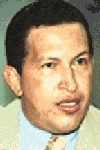International
Venezuela arrives at a crossroadsFor the E&P industry, the mid-November to mid-December period promises to be most interesting. Not only will OPEC ministers meet yet again to shore up prices, one of the member-countries will hold national elections shortly afterwards. Venezuela will elect a new president on December 6, and the campaign has not been pretty. The contest is a struggle between folks who want to continue reforming the oil and gas sector, and others who would revert to greater state control. Because oil and gas contribute more than 50% of all governmental revenue, this is no minor matter, especially when the economy is foundering. Leading the polls is Hugo Chavez Frias, 44, an infamous former paratrooper and officer in the Venezuelan army who led a failed coup attempt in 1992 against former President Carlos Andres Perez. Jailed for his coup leadership, he was pardoned in 1994. His statements on energy policy and other financial matters have been very inconsistent. Early on, Chavez blamed the current regime and the president of state oil firm PDVSA, Luis Giusti, for the drop in global oil prices. He said that PDVSA’s program of expanding Venezuelan crude output was a prime contributor to the oversupply of oil.
Chavez originally said that he would reverse PDVSA’s expansion and stop the awarding of exploration or production rehabilitation licenses to foreign companies. He even hinted at re-nationalizing the industry. However, as the election draws nearer, his rhetoric has changed. Chavez now claims that he will leave all foreign deals in place and merely slow the pace of PDVSA’s output expansion. His leading opponent for much of the race has been the 1981 Miss Universe, former beauty queen Irene Saéz Conde. The 37-year-old Saéz holds a political science degree and serves as mayor of the Chacao district of Caracas. She promises to battle inflation that runs over 30% and reduce unemployment to 6%, from 11.3%. She has not proposed changes to the oil sector, but Saéz has pledged to fight tax evasion and governmental corruption. Early in the race, Saéz led a field of 14 candidates and then remained a close second to Chavez. But in early October, she slipped to only 7.8% in the El Universal newspaper’s opinion poll. Chavez also fell to 41.6%, his lowest standing since last April. Coming up in the field is former Carabobo state governor Henrique Salas Romer, at 31.3%. Ahead of Saéz, in third place, is Luis Alfaro, at 8.2%. Salas, 62, is an economist running as an independent candidate. He points to his two successful terms as a governor and extols his managerial and decision-making capabilities. Not surprisingly, the business community favors the Yale-educated Salas. Alfaro, 77, is the nominee of Venezuela’s largest party, Democratic Action, considered a social democratic party. However, his campaign has not generated much energy. As Venezuelan elections go, this one is particularly vicious. Chavez says that most of the army favors his election, a claim disputed by lame-duck President Rafael Caldera, who notes that active soldiers cannot vote. Meanwhile, Perez has warned that the army might take control of the country just before Election Day, to avoid a Chavez victory. Indeed, Chavez said that he turned over evidence to the government of an alleged plot to assassinate him before the election. Most of his opponents also have accused him of plotting to install a military dictatorship, if he is elected. In turn, Chavez insists on talking about how he will be re-elected, even though he has not yet won a first term. Venezuela’s constitution requires incumbent presidents to sit out the next two consecutive terms before seeking election to that office again. However, Chavez repeatedly speaks about how he supports reform that would allow immediate re-election. The unpredictable Chavez scares E&P executives. While they’re not exactly excited about the alternatives, the consensus seems to be that anyone is better than this wild man is. In the meantime, foreign companies have slowed their investment into Venezuela, as they await the electoral outcome.
Neutral Zone find announced. Saudi Arabian Texaco (SAT) and Kuwait Oil Co. (KOC) have struck an oil and gas discovery on the Humma prospect in the Partitioned Neutral Zone (PNZ) shared by Saudi Arabia and Kuwait. Operated jointly by SAT and KOC, the Humma 4 is 25 km (16 mi) southwest of the firms’ Wafra oil field. The well was drilled to a 10,180-ft TD and encountered 726 ft of pay. Humma 4 tested 3,400 bpd of 32°API crude and sweet gas, with a flowing pressure of
1,649 psi. PNZ crude normally is significantly heavier, at about 18° to 23°API.
The companies will conduct additional seismic work and drilling before deciding next year
whether to develop the find. Copyright © 1999 World
Oil |
- Applying ultra-deep LWD resistivity technology successfully in a SAGD operation (May 2019)
- Adoption of wireless intelligent completions advances (May 2019)
- Majors double down as takeaway crunch eases (April 2019)
- What’s new in well logging and formation evaluation (April 2019)
- Qualification of a 20,000-psi subsea BOP: A collaborative approach (February 2019)
- ConocoPhillips’ Greg Leveille sees rapid trajectory of technical advancement continuing (February 2019)





